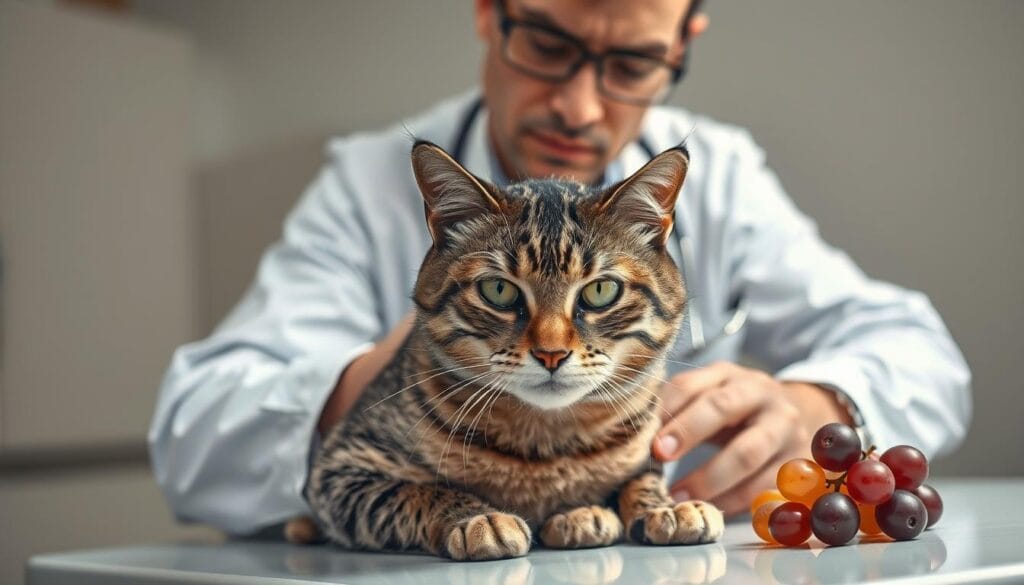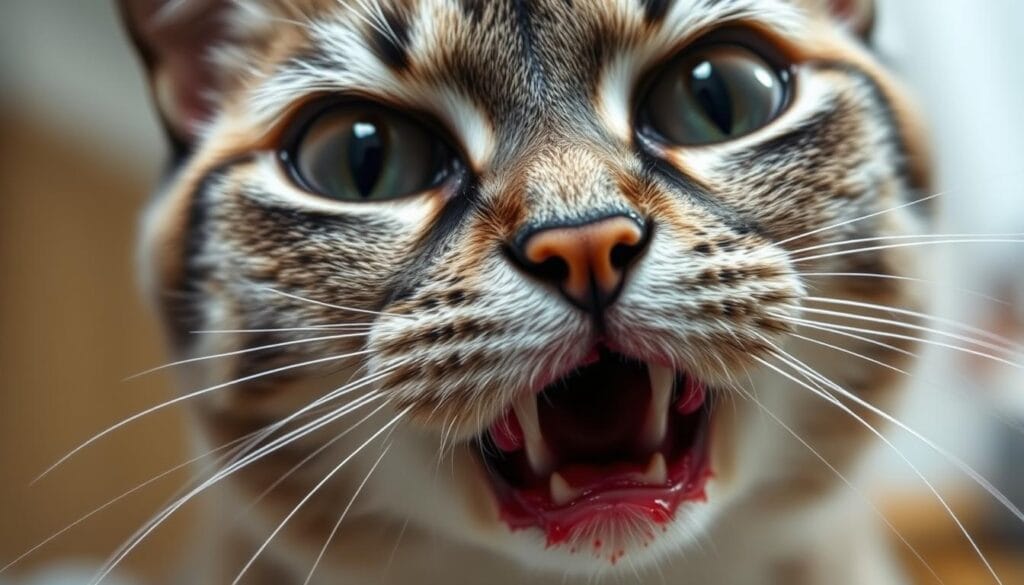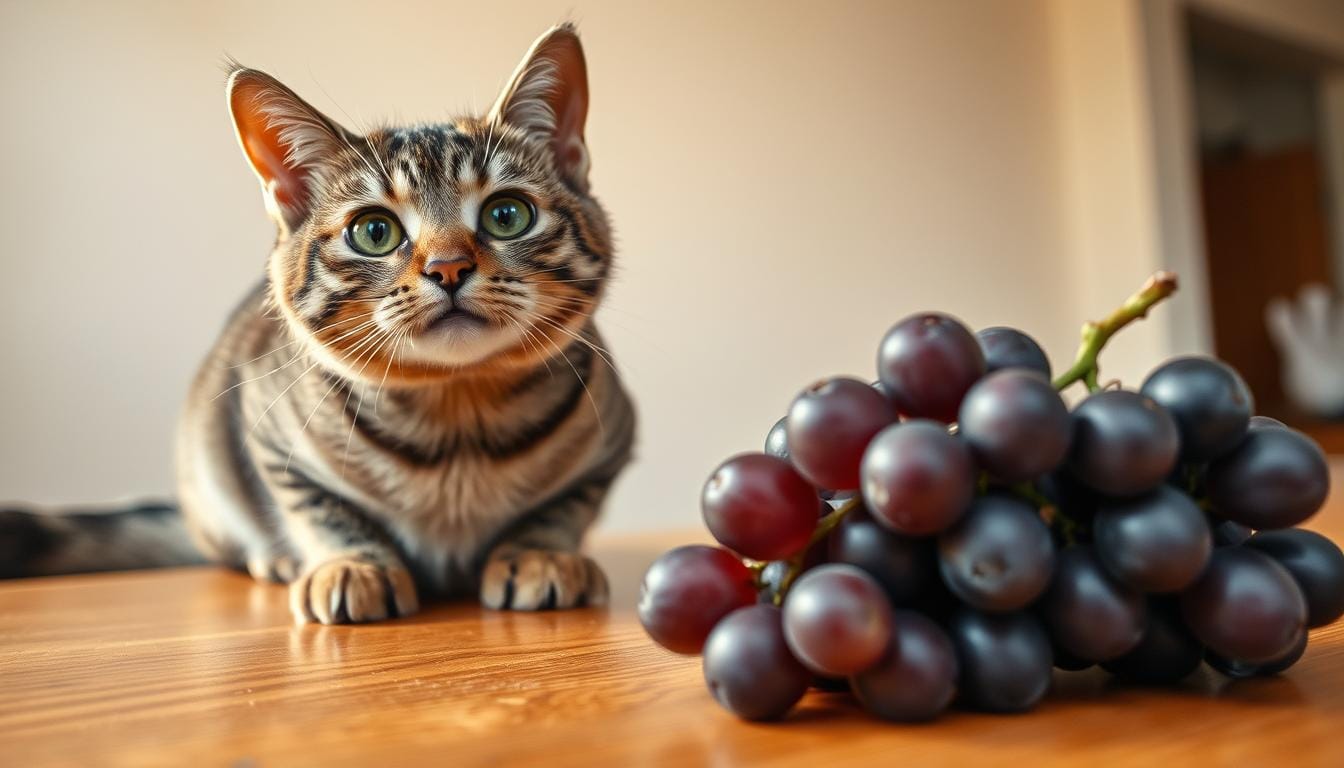Can Cats Eat Grapes? Vet Answers and Safe Alternatives
Picture this: You’re enjoying a quiet afternoon snack when suddenly those pleading eyes appear. Your furry companion watches intently as you pop grapes into your mouth. While sharing food creates bonding moments, some human treats hide surprising dangers for our four-legged friends.
Felines evolved as meat-eaters, lacking taste receptors for sweetness. This explains why most turn up their noses at fruit offerings. But accidents happen – a grape rolls under the couch, or clever paws snatch forbidden snacks. What appears harmless could trigger serious health complications requiring immediate care.
Table of Contents
Veterinary research reveals surprising toxicity risks in common foods. Through this guide, you’ll learn to recognize danger signs and respond effectively if exposure occurs. We’ll break down scientific findings into practical steps every pet owner should know.
Discover nutritionally appropriate treats that satisfy your companion’s cravings without compromising safety. From protein-rich bites to vet-approved snacks, you’ll find alternatives aligning with their biological needs. Stay informed, stay prepared, and keep those curious whiskers safe.
Understanding Feline Nutrition and the Role of Fruits
Your feline companion’s biology tells a story written in meat and protein. Unlike humans, these obligate carnivores evolved to extract nutrients almost entirely from animal sources. Their bodies prioritize muscle-building amino acids over sugary snacks or carb-heavy meals.
Feline Carnivore Basics
A cat’s digestive system operates like a protein-processing machine. Short intestinal tracts efficiently break down meat while struggling with plant fibers. They lack specific enzymes to digest cellulose, making most vegetation pass through undigested.
Nutritional Profile of Cats
High-quality cat food delivers precise nutrient ratios for optimal health. Essential components include:
- Taurine for heart and eye function
- Arachidonic acid from animal fats
- Pre-formed vitamin A (they can’t convert beta-carotene)
Commercial formulas mirror the nutritional density of prey animals. This eliminates guesswork while preventing deficiencies. Offering fruits risks disrupting this balance – their systems simply aren’t designed for sugary plant matter.
Can Cats Eat Grapes? Vet’s Perspective
Veterinary clinics occasionally face puzzling cases where a single grape triggers unexpected reactions. Though felines rarely seek out sweet fruits, their curiosity sometimes overrides instinct. When this happens, veterinarians face a critical challenge: predicting which patients will develop severe complications.

Research reveals about 15% of animals consuming these fruits show distress signals within 24 hours. Restlessness and appetite loss often appear first, followed by vomiting. While kidney damage occurs in fewer than 1% of cases, documented feline emergencies prove no species is immune.
| Symptom | Cats | Dogs | Action Required |
|---|---|---|---|
| Vomiting | 12% | 18% | Immediate vet visit |
| Kidney Issues | <1% | 3% | Emergency care |
| Lethargy | 8% | 14% | 24-hour monitoring |
The unpredictability alarms veterinary professionals. One patient might tolerate accidental ingestion, while another collapses from renal failure. There’s no safe threshold – even seedless varieties pose risks.
Why take chances? Modern pet stores offer protein-packed treats mimicking natural prey. Freeze-dried chicken or fish satisfy cravings without gambles. Your furry detective gets delicious rewards, and you gain peace of mind.
Risks of Grape Consumption: Assessing Toxicity in Cats
Hidden dangers lurk in common snacks we often consider harmless. While these fruits might seem innocent, their impact on feline health can be devastating. The primary threat involves kidney damage, which may escalate rapidly without prompt intervention.
Kidney Damage Considerations
Even small quantities can trigger acute renal issues. Research shows consuming 0.7 ounces of grapes per 2.2 pounds of body weight risks kidney damage. Raisins prove more dangerous, requiring only 0.11 ounces to reach toxic levels.
| Fruit Type | Toxic Amount | Body Weight |
|---|---|---|
| Grapes | 0.7 oz | 2.2 lbs |
| Raisins | 0.11 oz | 2.2 lbs |
When renal systems fail, urine production halts. Toxins accumulate, creating life-threatening conditions within hours. Immediate veterinary care becomes critical.
Other Toxicity Symptoms
Beyond renal crises, watch for these warning signs:
| Symptom Type | Potential Impact |
|---|---|
| Gastrointestinal | Vomiting, diarrhea, appetite loss |
| Neurological | Tremors, seizures, lethargy |
| Systemic | Multi-organ failure, dehydration |
The unpredictable nature of toxicity means reactions vary between individuals. Some felines show multiple symptoms simultaneously, while others display subtle changes first.
Recognizing Signs of Grape Poisoning in Cats
A dropped grape becomes a ticking clock for curious pets. Knowing what to watch for could save your companion’s life. Time-sensitive reactions demand immediate action – hesitation risks irreversible damage.

Early Warning Signs
Within hours of ingestion, subtle changes emerge. Vomiting often appears first, followed by diarrhea and unusual tiredness. Your pet might avoid food bowls or show disinterest in favorite toys.
Behavior shifts provide critical clues. Restless pacing or hiding in quiet spaces signals discomfort. Some animals groom excessively or vocalize differently when nausea strikes.
Progression of Symptoms
Unchecked poisoning escalates rapidly. After 24 hours, increased thirst and frequent litter box visits suggest kidney strain. Weakness becomes evident – your companion might struggle jumping onto furniture.
Advanced stages bring dangerous dehydration and abdominal tenderness. In severe cases, tremors or uncoordinated movements indicate neurological distress. These symptoms require emergency veterinary care to prevent organ failure.
Immediate Actions When Your Cat Eats Grapes
Seconds matter when accidental consumption occurs. Acting swiftly could mean the difference between minor intervention and life-threatening complications. Animal poison control experts emphasize immediate response protocols for these emergencies.
Emergency Response Protocol
Contact your veterinary clinic within 30 minutes of suspected ingestion. Provide these crucial details:
- Approximate quantity consumed
- Time of incident
- Specific fruit type (fresh/raisin/seedless)
Veterinary teams use this data to calculate toxicity risks. Never induce vomiting without professional guidance – improper methods can damage throat tissues or cause aspiration.
| Time Since Ingestion | Recommended Action | Success Rate |
|---|---|---|
| 0-2 hours | Clinical decontamination | 92% |
| 2-6 hours | IV fluids + monitoring | 78% |
| 6+ hours | Kidney function tests | 64% |
Keep emergency contacts visible – program your vet’s number and the ASPCA Animal Poison Control Center (888-426-4435) into your phone. Every minute counts when dealing with potential renal failure.
How Veterinarians Diagnose and Treat Grape Toxicity
When time is critical, veterinary teams spring into action with precise protocols. Quick assessment and targeted interventions become lifesaving measures for affected pets.
Diagnostic Tests and Examinations
Your vet starts by checking vital signs like heart rate and hydration levels. They’ll gently palpate the abdomen to detect kidney swelling or pain. Baseline blood tests measure kidney function markers and electrolyte balance.
Urine analysis reveals concentration ability – a key indicator of renal health. These initial results create reference points for tracking changes during treatment.
| Procedure | Purpose | Frequency |
|---|---|---|
| Blood Chemistry | Assess kidney function | Every 6-8 hours |
| Urinalysis | Check urine concentration | First 24 hours |
| Physical Exam | Monitor pain response | Hourly |
Treatment Protocols
Decontamination begins immediately if ingestion occurred within two hours. Vets administer safe vomiting-inducing agents under supervision. Activated charcoal then binds remaining toxins in the digestive tract.
Intravenous fluids flush the system while supporting acute kidney function. Continuous monitoring tracks urine output and blood values. Severe cases may require dialysis or specialized medications.
Recovery depends on early intervention and careful observation. Your vet will adjust protocols based on how your pet responds to each treatment phase. Follow-up checks ensure no delayed complications arise.
The Science Behind Grape and Raisin Toxicity
Behind the mystery of these toxic fruits lies a scientific puzzle that baffles researchers. While the exact compound remains unidentified, studies reveal patterns that help explain their dangers. Both fresh and dried varieties trigger reactions, ruling out seeds as the culprit.
Research on Tartaric Acid and Other Compounds
Scientists now focus on water-soluble substances in grape flesh. Tartaric acid emerges as a prime suspect – its levels vary across fruit types and spike during dehydration. This explains why raisins pack 4-5 times more concentrated toxins than fresh grapes.
Key findings from recent studies:
- Seedless and seeded grapes show equal toxicity in dogs and felines
- Dried grapes (raisins) require 1/6th the dose to cause harm
- Tannins and flavonoids may enhance adverse effects
Dehydration transforms the fruit‘s chemistry dramatically. What starts as a mild irritant becomes a renal hazard. Ongoing research explores how tartaric acid interacts with feline metabolism – some animals process it poorly, leading to crystal formation in kidneys.
This variability explains why no safe quantity exists. A single raisin might harm one pet while others tolerate several grapes. Until scientists isolate the exact compound, complete avoidance remains the only safe policy for all furry companions.
Safe Alternatives and Nutritious Treats for Your Cat
Your companion’s well-being starts with smart snack choices. While curiosity might drive them to sample human foods, their bodies thrive on meat-based foods. Modern pet science delivers safe options that satisfy natural cravings without risks.
Recommended Safe Snacks
High-quality cat food mirrors nutrients felines evolved to eat. These formulas pack animal proteins into various foods like kibble or wet varieties, avoiding dangerous human foods. Freeze-dried chicken or salmon flakes honor their carnivorous needs.
Vet-approved treats offer variety without compromise. Unlike human foods, these snacks contain no harmful additives. Single-ingredient options with turkey or duck provide novel flavors animals instinctively crave.
Steering clear of all human foods protects your pet’s health. Stick to trusted cat food brands for main meals, using species-specific foods as treats. This approach delivers precise nutrition while honoring natural dietary needs.
- Can Cats Eat Blueberries? Benefits and Risks Explained
- Can Cats Eat Pineapple? Safety Tips for Cat Owners
- Can Cats Eat Mango? What Every Cat Owner Should Know
- Can cats eat chicken and what are the health benefits?
- Can cats have chicken as a protein source?
- Can Cats Eat Raw Chicken? Safety Guide for Cat Owners
- Dry Cat Food Brands Loved by Cats and Trusted by Vets
- Best Cat Food for Sensitive Stomach
- Special Kitty Kitten Food – Learn the Pros and Cons
- prescription cat food-Top 10 Prescription Cat Foods
- Wet Cat Food for Kittens: Top Nutritious Choices 2025
- How Long Can Wet Cat Food Sit Out? Critical Facts
- American Veterinary Medical Association (AVMA)

